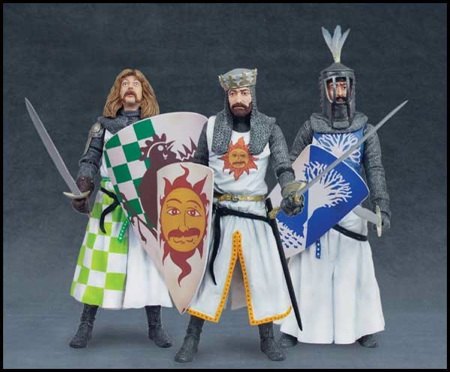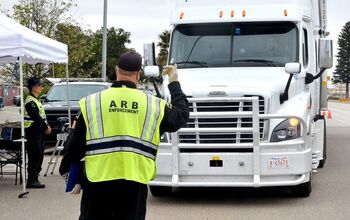Editorial: The California Air Resources Board Says Ni!
Do you ever feel trapped in Monty Python movie? The B&B discussion following Edward Niedermeyer’s post, CARB So Crazy: California To Ban Black Cars, made me think so. First soldier: What? A swallow carrying a coconut? King Arthur: I could grip it by the husk! First soldier: It’s not a question of where he grips it! It’s a simple question of weight ratios! A five ounce bird could not carry a one pound coconut. King Arthur: Well, it doesn’t matter. First soldier: Listen. In order to maintain air-speed velocity, a swallow needs to beat its wings forty-three times every second, right? King Arthur: Please! First soldier: Am I right? I’m no Michael Palin or Graham Chapman, but I’ve got an idea or two about white and black colored cars.
I track mpg with the fortitude of a deranged obsessive-compulsive disordered person checking to make sure the front door of his house is locked. Each time I top off my tank, I record how many miles I’ve driven since my last fill-up. I note whether that tank of gas was expended running about town or on the highway, whether I predominantly used the A/C, and I calculate the fuel efficiency. My ’05 V6 Jeep Liberty has about 58K miles on the odo and I have mileage readings for 54,478 of ’em. I’ve also tracked the mileage of my ’01 4-cylinder Honda Accord over the last 35K miles. Both of my vehicles are metallic black.
The California Air Resources Board proposes to regulate the reflectivity of car paint and windows to increase fuel efficiency. They theorize that lighter colored cars get better gas mileage because the roof reflects more sunlight, so the air conditioner doesn’t have to run as often due to lower interior temperatures. This is great news. Overall, my Jeep gets 16.35 miles per gallon. All I have to do is paint her white and my fuel efficiency will jump . . . how much?
Don’t know. Although CARB’s public presentation contains all sorts of numbers, charts and graphs, they neglect to reference a single study that validates their claim. Come on! All they have to do is get mechanically similar cars painted white or black and compare fuel consumption. Why the rush to take away a woman’s right to choose [the color of her car] (in my family, I chose the hardware and my wife picks the color) when we don’t know whether or not there will be a meaningful savings in CO2 emissions? After all, I thought most Californians were Pro Choice!
Living in north Texas, I am all too familiar with climbing into mobile solar ovens after a long day at work. When it’s really hot outside, everyone has their A/C on. So CARB’s savings claims are based on the fact that four months of each year evening commute temperatures range between 62° F and 77° F—mid-range temperatures where non-reflective cars would need the A/C on after a long soak in the sun but “cool cars” would not.
However, the very Lawrence Berkley National Laboratory (LBNL) study that CARB uses to support their proposal debunks this assumption. The Cooling Load Reduction chart (page 14, “Cool Coatings for Cool Cars: A measure to cool the globe”) shows that by 5 p.m. there is NO difference in air temperature measured at the anterior-heading compartment (i.e., where the driver’s head would be). The “cool car” soaking in the sun heats up slower, but by about 2 p.m., the gap has closed and the interior temperatures remain virtually identical the remainder of the day. Therefore, the only sun soaked vehicles that would see a decrease in A/C usage would be those that leave work at lunchtime, not the masses in evening commute.
When I drive with the A/C on, I get 1.13 (Jeep) and 1.16 (Accord) fewer miles per gallon. There would be no change in A/C usage during the morning since solar soak would not yet be a factor. Additionally, as the LBNL study shows, the proposed “cool car” protections would be of no help during my evening commute. However, over the protestations of my cholesterol clogged arteries, I make a run for fast food about four days a week at lunchtime. Using CARB’s dubious assumption of four months’ savings per year, I could satisfy sixty-nine more Big Mac attacks without switching on my A/C each year. But I don’t travel far—about (generously) six miles round trip.
So what would my annual savings be? 0.68 (Accord) to 1.96 gallons (Jeep).
Ladies and Gentlemen, let the debate carry on.
First soldier: Am I right?
King Arthur: I’m not interested!
Second soldier: It could be carried by an African swallow.
First soldier: Oh yeah, an African swallow, maybe, but not a European swallow. That’s my point.
Second soldier: But then the African swallow’s not migratory . . .
More by William C Montgomery
Latest Car Reviews
Read moreLatest Product Reviews
Read moreRecent Comments
- MrIcky 2014 Challenger- 97k miles, on 4th set of regular tires and 2nd set of winter tires. 7qts of synthetic every 5k miles. Diff and manual transmission fluid every 30k. aFe dry filter cone wastefully changed yearly but it feels good. umm. cabin filters every so often? Still has original battery. At 100k, it's tune up time, coolant, and I'll have them change the belts and radiator hoses. I have no idea what that totals up to. Doesn't feel excessive.2022 Jeep Gladiator - 15k miles. No maintenance costs yet, going in for my 3rd oil change in next week or so. All my other costs have been optional, so not really maintenance
- Jalop1991 I always thought the Vinfast name was strange; it should be a used car search site or something.
- Theflyersfan Here's the link to the VinFast release: https://vingroup.net/en/news/detail/3080/vinfast-officially-signs-agreements-with-12-new-dealers-in-the-usI was looking to see where they are setting up in Kentucky...Bowling Green? Interesting... Surprised it wasn't Louisville or Northern Kentucky. When Tesla opened up the Louisville dealer around 2019 (I believe), sales here exploded and they popped up in a lot of neighborhoods. People had to go to Indy or Cincinnati/Blue Ash to get one. If they manage to salvage their reputation after that quality disaster-filled intro a few months back, they might have a chance. But are people going to be willing to spend over $45,000 for an unknown Vietnamese brand with a puny dealer/service network? And their press photo - oh look, more white generic looking CUVs. Good luck guys. Your launch is going to have to be Lexus in 1989/1990 perfect. Otherwise, let me Google "History of Yugo in the United States" as a reference point.
- Schen72 2022 Toyota Sienna, 25k miles[list][*]new 12V battery, covered by warranty[/*][*]new tires @ 24k miles[/*][*]oil change every 10k miles[/*][*]tire rotation every 5k miles[/*][/list]2022 Tesla Model Y, 16k miles[list][*]nothing, still on original tires[/*][/list]
- Kjhkjlhkjhkljh kljhjkhjklhkjh Elon hates bad press (hence TWITTER circus) So the press jumping up and down screaming ''musk fails cheap EV'' is likely ego-driving this response as per normal ..not to side with tesla or musk but canceling the 25k EV was a good move, selling a EV for barely above cost is a terrible idea in a market where it seems EV saturation is hitting peak


































Comments
Join the conversation
MikeInCanada, I agree. I suspect the interior color is more important than the exterior color. It is the dark interior that absorbs the rays coming though the glass instead of reflecting them. I doubt the outside color of the engine compartment or the trunk have much relevance. The top and the doors might matter, but the interior not being able to reflect out much solar radiation has got to matter when in comes to air conditioning. By the way, I hate black interiors. IMO the default colors for interiors should be light tan or light gray with the exception of the top half of the dash which should be mat black.